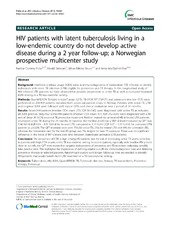| dc.contributor.author | Pullar, Nadine Durema | en_US |
| dc.contributor.author | Steinum, Harald | en_US |
| dc.contributor.author | Bruun, Johan Nikolai | en_US |
| dc.contributor.author | Dyrhol-Riise, Anne Ma | en_US |
| dc.date.accessioned | 2015-01-07T12:39:28Z | |
| dc.date.available | 2015-01-07T12:39:28Z | |
| dc.date.issued | 2014-12-17 | eng |
| dc.identifier.issn | 1471-2334 | |
| dc.identifier.uri | https://hdl.handle.net/1956/9085 | |
| dc.description.abstract | Background: Interferon-γ release assays (IGRA) serve as immunodiagnostics of tuberculosis (TB) infection to identify individuals with latent TB infection (LTBI) eligible for preventive anti-TB therapy. In this longitudinal study of HIV-infected LTBI patients we have observed for possible progression to active TB as well as evaluated repeated IGRA testing in a TB low-endemic setting. Methods: QuantiFERON TB-Gold In-tube® assay (QFT), TB-SPOT.TB® (TSPOT) and tuberculin skin test (TST) were performed on 298 HIV-patients recruited from seven out-patient clinics in Norway. Patients with active TB, LTBI and negative IGRA were followed with repeat QFTs and clinical evaluation over a period of 24 months. Results: Seven HIV-patients (median CD4 count 270; IQR 50–340) were diagnosed with active TB at inclusion, all IGRA positive. Sixty-four (21%) HIV-patients (median CD4 count 471; IQR 342–638) were diagnosed with LTBI and of these 39 (61%) received TB preventive treatment. Neither treated nor untreated HIV-infected LTBI patients developed active TB during the 24 months. At baseline, the median interferon-γ (INF-γ) level measured by QFT was 3.48 IU/ml (IQR 0.94 – 8.91 IU/ml) for treated LTBI compared to 1.13 IU/ml (IQR 0.47 – 4.25 IU/ml) for untreated LTBI patients (p = 0.029). The QFT reversion rates were 75% for active TB, 23% for treated LTBI and 44% for untreated LTBI, whereas the conversion rate for the non-TB group was 7% despite no new TB exposure. There was no significant difference in the trend of INF-γ levels over time between treated and untreated LTBI patients. Conclusion: The prevalence of LTBI is high among HIV-patients, but the risk of developing active TB seems to be low in patients with high CD4 counts in this TB low-endemic setting. In several patients, especially with baseline IFN-γ levels close to cut-offs, the QFT tests reverted to negative independent of preventive anti-TB treatment indicating possibly false positive tests. This highlights the importance of defining reliable cut-offs for immunodiagnostic tests and deferring preventive therapy in selected patients. Randomized studies with longer follow-up time are needed to identify HIV-patients that would benefit from LTBI treatment in a TB low-endemic setting. | en_US |
| dc.language.iso | eng | eng |
| dc.publisher | BioMed Central | eng |
| dc.rights | Attribution CC BY | eng |
| dc.rights.uri | http://creativecommons.org/licenses/by/4.0 | eng |
| dc.subject | Tuberculosis | eng |
| dc.subject | HIV | eng |
| dc.subject | IGRA | eng |
| dc.subject | QuantiFERON-TB | eng |
| dc.subject | Tuberculin skin test | eng |
| dc.subject | Norway | eng |
| dc.subject | TB low-endemic | eng |
| dc.subject | Preventive therapy | eng |
| dc.subject | Follow-up | eng |
| dc.title | HIV patients with latent tuberculosis living in a low-endemic country do not develop active disease during a 2 year follow-up; a Norwegian prospective multicenter study | en_US |
| dc.type | Peer reviewed | |
| dc.type | Journal article | |
| dc.date.updated | 2014-12-22T08:05:03Z | |
| dc.description.version | publishedVersion | en_US |
| dc.rights.holder | Copyright 2014 Pullar et al.; licensee BioMed Central | |
| dc.rights.holder | Nadine Durema Pullar et al.; licensee BioMed Central Ltd. | |
| dc.source.articlenumber | 667 | |
| dc.identifier.doi | https://doi.org/10.1186/s12879-014-0667-0 | |
| dc.identifier.cristin | 1211788 | |
| dc.source.journal | BMC Infectious Diseases | |
| dc.source.40 | 14 | |

